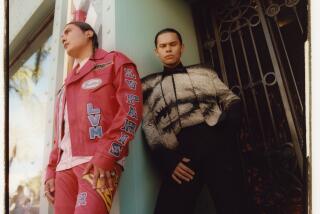The Positives and Negatives of Mixing Passion, Photography
- Share via
Nothing is quite as exciting for an aspiring writer as reading for the first time the early stories about artists, such as Joyce’s “Portrait of the Artist as a Young Man,” Thomas Mann’s “Tonio Kroger” and the novels of George Sand and Thomas Wolfe. They are books that don’t always age well, however, and are best read at the point in time when all feels possible, when the future feels ripe with the promise of passion and art and immortality.
I’m sad to report that I came to Whitney Otto’s third novel, “The Passion Dream Book,” about 25 years too late to appreciate her wistful story about the bohemian life. “The Passion Dream Book” is a slender love story about two photographers, more serious about their art than about each other. Romy, a young Pasadena native of Italian descent, meets Augustine, one of a mere handful of black kids at her local school. The plot of the novel follows their relationship as it evolves from hesitant adolescent friendship in silent movie era Hollywood to live-in lovers in Harlem during its Renaissance, to the Paris art scene in the ‘20s and eventually to domestic bliss in San Francisco in the ‘50s as the beat movement takes off.
The fiction writer’s job is to create believable characters and events, not to simply report about them. This novel reads like an outline of a novel yet to be written. For all of Otto’s lush words about artists, “The Passion Dream Book” never translates into successful art. (The one memorable character brought to life in a sweet, succinct portrait is that of a retiring Italian Renaissance artist named Allessandro Marcel. He is known as “Sandro of the Birds” because that’s about all he paints.)
Otto provides a survey course on the Italian Renaissance, with thumbnail considerations of the work of Giotto, Ghiberti, Brunelleschi and da Vinci. The book opens, in fact, in 16th century Florence with the story of a young girl, Giulietta (Sandro’s daughter), who has a crush on Michelangelo. (Truly irritating is Otto’s least believable plot detail that concerns a discarded chip of a marble curl from Michelangelo’s statue of David--from what part, you can’t help wonder--an inherited objet Romy will schlep around with her in a small wooden box made by her ancestor, that very Giulietta.) And there’s the “A Bridge of Biographies” chapter that tells us about famous American expatriate artists. But what is the point?
After living together for years in Harlem, Romy leaves Augustine. He follows her to Europe, where they briefly unite before she sets off again. She never leaves any forwarding addresses. No wonder so much time passes between get-togethers! And while Romy is living in Dorset, England, there’s a little thing going on outside called World War II. Not once do we feel that she is in any danger or has given any thought to the war. (It is apparent the author hasn’t, either.)
The plot feels engineered, the dialogue lifeless and at times downright embarrassing. Listen to Otto’s rich art patron, Lorraine Hume Ross (a cruel take on Mabel Dodge Luhan?): “I believe in the pure, undiluted spirit of the Indian and Negro people. I am estranged from Judeo-Christian philosophy. My desire is to become the child of a more primitive god.” (Does Lorraine ever think about more mundane stuff, along the lines of what the cook will make for dinner?)
“The Passion Dream Book” is hilariously pretentious. It is as superficial as a Danielle Steel novel, but less fun to read because there aren’t any sex scenes. In the Paris sequence, Romy collides with famous writers and artists she gives fictitious names to. Readers will not have a difficult time guessing that Martha and Cory are paper doll stand-ins for Gertrude Stein and Alice B. Toklas. They may recognize Hemingway in the much-married writer Ben, and guess that Polly stands in for model Kiki of Montparnasse. In the brief London interlude, Vanessa Bell, “a woman painter,” makes a one-sentence appearance. And yes, Otto asks some of the right questions about art and why people feel driven to create it.
Let’s hope next time out that Whitney Otto will have had her fill of artistic navel gazing and return to the writer’s less glamorous job of good storytelling, as she did in “How to Make an American Quilt.”
More to Read
Sign up for our Book Club newsletter
Get the latest news, events and more from the Los Angeles Times Book Club, and help us get L.A. reading and talking.
You may occasionally receive promotional content from the Los Angeles Times.








